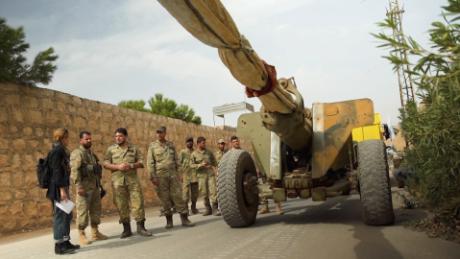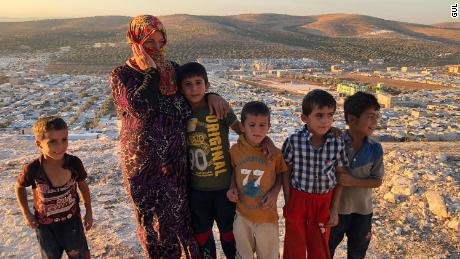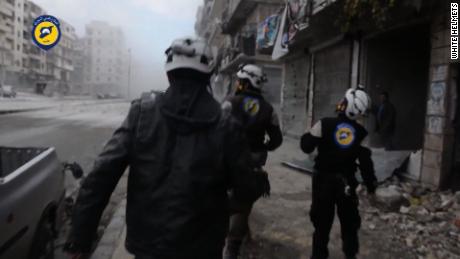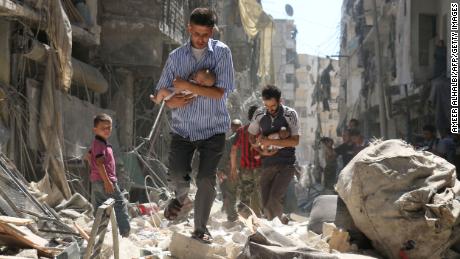Story highlights
- Russia started airstrikes two weeks ago and they are now looking to increase their operation
- So far airstrikes have been "effective, but in a typically Russian 'sledgehammer' manner"
- A reason for Russian urgency is that next month the G20 meets in Turkey
(CNN)Two weeks after they started, Russian airstrikes in Syria are ratcheting up -- and are being closely coordinated with regime ground forces as they try to seize rebel-held territory. According to many observers of the Syrian conflict, the next month will be critical, politically and militarily.
Among the things to watch for:
ŌĆó How are Russian combat aircraft performing and how accurate are their strikes?
ŌĆó Will Russia expand the operation, using more cruise missiles fired from way beyond Syrian borders, for example?
ŌĆó Will Syrian ground forces, backed by Iranian and Hezbollah militia, take advantage of the strikes to regain territory?
ŌĆó How will Saudi Arabia and Turkey respond to the Russian airstrikes, many of which are aimed at factions in Syria they support?
ŌĆó Will Russian President Vladimir Putin be in a position of strength -- if not able to declare victory -- when he attends the next G20 summit, in Turkey, in mid-November?
The strikes so far
The Russians appear to be focusing on three areas:
ŌĆó The northern province of Idlib, next to the regime coastal stronghold around Latakia and where al Qaeda affiliate al-Nusra is strong.
ŌĆó Southeast of Latakia in the Ghab plain and elsewhere in Hama province, to prevent rebels putting further pressure on the coast.
ŌĆó Areas around Syria's largest city, Aleppo, where ISIS, a variety of rebel groups and government forces are all present -- and where a major regime offensive appears imminent.
There are about 30 Russian strike aircraft at Hmeymim airbase near Latakia. The workhorses are the Su-24M Fencer and Su-25 Frogfoot. The Fencer was designed forty years ago but has been updated with modern avionics and navigation systems. There are about a dozen of each stationed at Hmeymim.
The Fencer was designed to perform high-speed ultra-low level strikes, but in Syria it appears to be operating at higher altitudes to avoid the rebels' shoulder-held surface-to-air missiles (MANPADs.)
At full throttle, the Russian aircraft can carry out as many as 80 sorties a day. But there's some doubt among Western analysts about the accuracy of their targeting.
Peter Felstead, editor of Jane's Defense Weekly, says "the air campaign has been effective, but in a typically Russian 'sledgehammer' manner."
"Video released by the Russian MoD, in fact, shows no evidence or precision targeting; some munitions, in fact, looked as if they struck open fields," he told CNN.
David Cenciotti, who runs The Aviationist website, says "Russian Su-24 and 25 jets have made significant use of unguided fragmentation bombs ... Su-24s were also seen dropping RBK 500 cluster bombs."
These "aren't precision weapons," according to U.S. Air Force intelligence chief Lt. Gen. Robert Otto.
"To me, it was representative of what you'd expect from dumb bombs, being dropped from airplanes at medium altitudes, which is not that impressive," he told reporters in Washington last week.
More sophisticated aircraft in Syria, such as the Su-34, are equipped with satellite-guided missiles. Even so, Cenciotti says, "the Russian air force lacks the breadth of precision weapons and targeting systems fielded by the most capable of its Western counterparts."
The Russians insist that with aerial reconnaissance by drones and satellite images, their targeting is accurate. In one Moscow briefing, Col. Gen. Andrei Kartapolov said: "There's panic and desertion among [the rebels]. Because of this, we will not only continue with our strikes, but increase their intensity."
Expanding the campaign
One of the surprises of the Russian campaign so far was the firing of new Kalibr cruise missiles on October 7 by warships in the Caspian Sea, some 1,500 kilometers away. Their performance is disputed. The Russian Defense Ministry said the cruise missiles had "successfully hit all assigned ISIS targets;" U.S. officials told CNN's Barbara Starr that 15% (four out of 26) of the missiles fell in Iran.
Whatever their fate, Peter Felstead at Jane's said the use of such missiles was intended as a show of Russian military prowess, and "provided a live demonstration to the world -- and the Russian public -- that Russia has this capability: it can match the Americans in mounted stand-off attacks using cruise missiles."
The use of such missiles has not been repeated, yet. According to some analysts, that's because the Russians used up most of their Kalibr missiles in that one salvo.
But "more astonishing turns are almost certain to come," says Pavel Baev at the Brookings Institution.
Baev says Russia's options for beefing up the Syria campaign include firing air-launched cruise missiles from bombers a long way from Syria, and cruise missile salvoes from submarines in the Mediterranean. There is also speculation that Russia may send its only aircraft carrier, the refitted Admiral Kuznetsov, into the Mediterranean.
The Russians have already added Mi-24P attack helicopters to the mix. Recent videos of the fighting in the critical Ghab plain appear to show Mi-24 attacking rebel-held positions at very low levels while throwing off flares. Experts at IHS/Jane's who study military hardware say the Mi-24s are almost certainly Russian because of the equipment they have, such as anti-tank rockets.
The supply chain
So far, David Cenciotti says, the Russians have been able to support the expanding Syrian expedition with a variety of cargo aircraft.
"This was the first time the Russians used their ageing fleet of cargo planes for an overseas deployment," he told CNN.
But Baev believes that sustaining the different planes and helicopters deployed will be a "logistical nightmare, since all supplies have to be shipped by several naval transports from Novorossiysk and Sevastopol ... Transport aircraft can add only so much to this stretched supply line." And the Russian naval facility at Tartus consists of a single pier.
Some analysts say that one possible problem for the Russians will be resupplying the bombs and missiles their aircraft are using up at a rapid rate.
President Putin has already insisted this is not an open-ended commitment: "This support will be time-limited, while the Syrian army conducts advance operations," he said at the end of September.
If the regime fails to stabilize the area around Damascus and makes little headway in securing corridors to Hama and the coast, do the Russians send in ground troops? It seems unlikely. Again, the logistical chain would be very challenging, and Moscow has made it clear it won't add ground forces to its expedition. That would represent indefinite mission creep.
So the Russians will want results quickly.
Russian escalation
Analysts say there are signs that the Russians are readying the second runway at Hmeymim, which is currently used for parking planes. Satellite images show the construction of concrete parking pads that would allow both runways to be used. That would be useful if a higher rate of sorties is planned or if Moscow adds to the 30-plus combat aircraft already in Latakia.
Russian planes flew 88 sorties in a 24-hour period earlier this week, according to the Ministry of Defense in Moscow, a much higher tally than normal. Pavel Baev believes the Russian campaign will intensify. Rebel groups in some areas are not used to aerial attacks, he says, but "this tactical surprise is by definition short-term, and in order to continue making a difference -- and for the campaign to really resonate -- Russia needs to escalate."
This is for two reasons, analysts say. Intense airstrikes should allow Syrian ground forces, supported by Iranian and Iraqi Shia elements, to recapture ground from rebels. Their coordination is run by a Joint Operations Room in Baghdad which has become known as the 4 + 1 -- Syria, Russia, Iran, Iraq and the Lebanese Shia militia Hezbollah.
One significant sign of their progress could come around Aleppo, where multiple reports speak of a major troop buildup. The semi-official Iranian Fars news agency reported Wednesday "preparation of the Syrian Army, the Lebanese Hezbollah and the Russian Air Force for a massive operation under a Joint Command Room" to retake the city in coming days. Two senior Iranian commanders have already been killed in the area.
The second reason for Russian urgency is that next month the G20 meets in Turkey. President Putin has said he will attend. The Russian goal, according to several analysts who spoke to CNN, is to be able to show that its campaign is working and it therefore has a decisive role in charting any future political settlement in Syria. The Syrian expedition only works for Moscow if it restores its place at the negotiating table.
The Gulf response
That "decisive role" was likely on the agenda when President Putin met the Saudi Defense Minister Mohammed bin Salman in the Black Sea resort of Sochi last weekend.
After the talks, Russian Foreign Minister Sergei Lavrov said that Russia and Saudi Arabia "better understand how to move toward a political solution" in Syria. "Above all, it is to not let a terrorist caliphate take over the country," he added.
But the Saudis are very hostile to the "4 + 1"alliance, which groups powerful Shia constituencies with Russia. They have sponsored rebel groups now being targeted by Russian airstrikes. Salman said after the Sochi meeting that Saudi Arabia would only support a solution that led to the exit of Syrian President Bashar al-Assad.
In the meantime Saudi Arabia is reinforcing its allies with hundreds more U.S.-made TOW anti-tank missiles, which have blunted regime advances. Turkey too has been angered by Russian intervention and especially intrusions into its airspace. It also has allies among the rebel groups, especially Ahrar al Sham, an Islamist group of growing importance.
There is the prospect -- or probability -- that the war of attrition on the ground will intensify, but without any resolution. So far, according to reports from Syria, regime forces have gained some ground between Homs and Hama, but largely in rural areas. They are some way yet from reclaiming enough territory to guarantee corridors from Damascus to the coast.
Calling Russia's bluff
Baev and his colleague at Brookings, Jeremy Shapiro, argue the U.S. should let President Putin find out just how difficult it is to make an impact on the Syrian battlefield.
Shapiro says the White House should heed the words of Napoleon, who once famously warned: "When your enemy is making a mistake, do not interrupt him."
These are early days in the Russian campaign. There might yet be suicide bombings of one of the Russian facilities, or a rebel group could get lucky with a Katyusha missile. Jane's experts believe at some point a Russian helicopter, at least, is likely to be downed, given that they are operating at tree-top level.
For now, all sides appear to believe that they can achieve decisive influence in Syria through force of arms. Only when (or if) there's consensus that the huge amount of weaponry deployed is not going to change the balance of power will the pathway to a political solution begin to open.




















































































































































